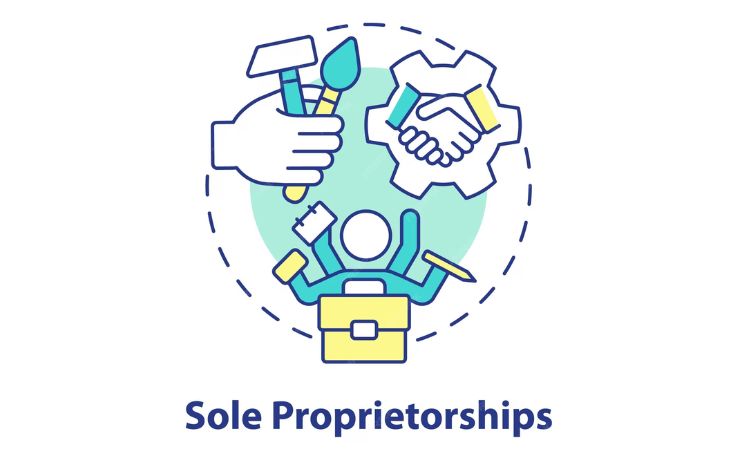Greeting fellow readers! You must have come to this space because you have a dream to work for yourself and only for yourself. We understand the plethora of overwhelming thoughts that are shadowing your logical reasoning to this goal of yours. The energy and hope that are mixed inside your soul are the true spirit you need to hold onto. This dream of being a sole proprietor is a tough call when it comes to a stable income. But to venture towards a path is always encouraged and will give you the strength to justify the ideal meaning of life.
Business Outreach Magazine will walk you through some detailed, yet simple and easy-to-understand information about some advantages of a Sole Proprietorship with some related facts. Firstly, you have to understand that sole proprietorship is different from other types of businesses. It is basically a hobby you wish to scale and maybe turn into a source of income in the future.
What is a Sole Proprietorship?

A Sole Proprietorship refers to a business that is unincorporated and has a single owner who receives all the profits or losses from the business. The owner is also named as a sole trader whose income taxes are logged as personal that are earned from the profits of the business. The owner can start the journey with their personal names or can also resort to fictitious names like ‘Joe’s Bakery’ or ‘Sakshi’s Beauty Salon’. In this scenario, the name of the business owner is the same person or it can be called a trading name. A sole proprietorship is subject to the entire profits or losses from the business. The sole proprietorship does not necessarily require any votings or meetings unlike corporations or other business models. The beauty of being a sole proprietor is that it is the easiest form of business with minimal government regulations.
A major disadvantage of such business models is that all the liabilities from the business directly address the owner. Any debts incurred from the business is the responsibility of the owner. Creditors can file lawsuits against the business owner, who if loses the lawsuits can encounter losing their own money or their personal assets. This can cause putting personal assets on the line to overcome any liabilities. This may sound easy to start a sole proprietorship due to less tax complications and no legal registration with a state or a government authority. But the entire spectrum of business plans lies with the efficiency and planning of the owner. For being a sole proprietor, different countries have different rules.
A Sole Proprietorship can also be termed Individual Entrepreneurship. There is no separate business entity in a sole proprietorship. Both the owner and the business are tied together.
An in-depth understanding of Sole Proprietorship
A Sole Proprietorship has no connection with being a limited liability company (LLC), limited liability partnership (LLP), or corporation (corp). It is simple and considered the same entity as the owner. You can say a sole proprietorship for dummies is the best way of putting this because of no tax complications and less paperwork. However, it is important to keep in mind that the owner is liable to every asset or liability attached to the business.
This means all the profits are the profits of the owner and all the losses are the losses of the owner. If the business thrives and witnesses huge margins of profit the business owner will ripe the entire sweetness of the fruit.
But if there are significant amounts of losses incurred from the business, the owner has to deal with the liabilities tied to the venture and has to pay back the creditors. There can be challenging times, when the residential house of the business owner, car or any other personal assets have to be used to pay for the loans which were initially gathered as capital for the business. Generally, a sole proprietorship has smaller scalability. This means the business is locally based with a local customer base.
The customer writes payments to the name of the owner, even if their trade name is different. If the structure and planning is done properly, a sole proprietorship can be an efficient side hustle for a working professional. If in the future, the business is encountering expanding profits and requires employees to handle the operations, this means it is time to change the structure to a corporation, LLC, or LLP.
A Sole Proprietorship does not require an owner to create a separate business bank account. They can undergo all business transactions via personal accounts. This allows the sole proprietor with several tax advantages and also does not require any registration with the state which saves a lot of maintenance fees. Although a license or permit may be required to run the business depending on its type. Since being a sole proprietor requires no registration fees, the owner can expedite the process of starting the business. This is a very inexpensive method of starting any form of business.
Since the paperwork is so less and government regulations are minimal, a lot of time and resources are saved in reporting income reports to the public and the authorities. Regarding taxes, a sole proprietorship has to pay one time, unlike corporations. The business entity does not have to pay taxes and the owner will pay tax from their personal income. Also, losses from the business get adjusted with the sole proprietor’s other sources of income which is an advantage when filing taxes.
There are some downsides to being a sole proprietor. The sole proprietorship business disadvantages are also daunting when considering this as an income source. Businesses run out of business every now and then. And accidents happen all the time. If the sole proprietor or an employee of the business comes across accidents that are business-related, a negligence issue pops up which can cost personal assets. The following consequences make it a nightmare for a sole proprietor. The owner also has to pay unemployment tax on employees under the business in case such a scenario occurs, where no unemployment benefits can be enjoyed by the owner due to no government support.
Another major issue is gathering capital from banks or other well-structured channels. A Sole Proprietor does not have the option to sell equity for getting more funds. An individual’s credit history is very crucial for getting any sort of loan from banks. A sole proprietor does not have any sort of support from the government due to the less paperwork and tax advantages being involved. Banks tend to provide loans or some other forms of credit to start-ups or businesses which have a well-informed business plan or a track record. If the sole proprietor has an untimely death, the business rarely survives in that case. This makes the venture less valuable and banks do not prefer to pass on loans to such an unstable format of business.
Being an LLC has its own perks where creditors cannot seize the business owners’ houses or other personal assets. Generally, how it goes is that an individual starts as a sole proprietor. Then as time passes and the business keeps expanding, the owner changes the business to an LLC, LLP, or a corp.
A Sole Proprietorship Business Example

It is the general idea of a small business or a passion project to start as a sole proprietorship and later evolve into an LLP, LLP or a corp due to the successful expansion of the business.
In India, a real-world example can be Flipkart. The company was started by Binny Bansal and Sachin Bansal in 2007. The company is headquartered in Bangalore, Karnataka, India. Flipkart started selling books in India and later expanded into other consumer products like mobile phones, furniture, clothing, groceries and other household essential products.
Flipkart later got incorporated in Singapore as a privately acquired company. The revolution caused by Flipkart in the e-commerce sector bank in the day sure holds some legacy. In August, 2018, Flipkart was acquired by Walmart with a 77% stake in the company. Flipkart is a direct competitor to Amazon and Snapdeal. The company sells over 150 million products and has investors like Tencent, SoftBank and Walmart. Flipkart achieved a net valuation of $ 37.6 billion in July 2021.
In 2007, Binny Bansal and Sachin Bansal, who were IIT Delhi graduates and Amazon employees, focused on a well-designed business model where their primary objective was to sell books. By 2008, Flipkart slowly gained some traction and they were receiving 100 orders a day. In 2010, a Bangalore-based book service named ‘WeRead’ was acquired by the company from Lulu.com. In 2011, Flipkart bought ‘Mime360.com’, a business based on digital distribution, and ‘Chakpak’ which was a bollywood library portal for digitized content. In the retail sector, Flipkart took over ‘LetsBuy’ in 2012 and ‘Myntra’ in 2014. In April, 2015, ‘Appiterate’, a marketing firm in mobile automation was acquired by Flipkat which helped them in improving their mobile services. ‘MapMyIndia’ which is a digitized mapping service was acquired by Flipkart in December, 2015 followed by ‘PhonePe’, a UPI mobile transaction platform and Jabong, which is a fashion retailing platform.
Flipkart witnessed almost every form of success in every corner of their journey which is a proof from the several partnerships and agreements the company signed with others. Flipkart became an exclusive Indian retail partner for Motorola’s Moto G smartphone, which was a sensational product from emerging smartphone users in India.
The company also introduced something called ‘Big Billion Day’ in October, 2016 to celebrate Diwali season and the anniversary of the company. The event became so popular and witnessed insurmountable traffic, that the website crashed. The following year in 2015, ‘Big Billion Day’ was introduced as a multi-day event with enhanced supply chain management and with more fulfillment centers. In 2018, Walmart acquired Flipkart and started a new journey.
Some Special Considerations in Being a Sole Proprietorship
When you decide to start a business, it is always advisable to start small. That is the first step to a goal. Starting with a small profit margin and slowly figuring out challenges like hiring the first employee, sorting out administrative processes and investing in the right places to safeguard the future of the business. Deciding on sole proprietorship although has less taxes and paperwork but the stakes are high and thinking it to be long term from the first day is not at all logical. A sole proprietorship can hire ‘n’ number of employees like freelancers, creative experts, emerging startups or an already successful business with a physical brick and mortar workspace. In such cases, the sole proprietor is entirely responsible for the wages, health and safety of all the employees.
If a sole proprietor decides to incorporate the business, they can readily do that with the help of some paperworks. Firstly, they need to restructure the business into an LLC by deciding a name for the company. After a decision is made on the name, the owner needs to check whether the name is acquired by some other business or not. If the name is available and not used by any other company, the owner must file the article of the organization with the respective state or region where the business will be based upon. After the completion of filing the company, an LLC transaction agreement must be created which will mention the structure of the business. Lastly, an employee registered number should be gathered which will connect the relevant information about the business with the government tax authorities.
How Can You Start a Sole Proprietorship?
In order to start a sole proprietorship, you just need to readily commence the business whenever you can. It is as simple as that. There is no registration required to compete with the state in which you are living. But it is required of the business owner to get a permit or a license with the region of the business if necessary. Such permits or licenses might cost a nominal fee for records keeping with the government. The type of license might vary depending on the product of the business.
It can be selling food or alcohol, or operate business from a store by putting up a sign or venture from the personal home. Apart from these, whether an individual is a freelancer, or an independent contractor, a sole proprietorship can start inadvertently. There is a common misconception that a side gig or a side hustle is not consequential considering it involves less participation from the business owner. But it is possible to carry on with your passion project while continuing your day job.
This helps create productivity due to less involvement and without worrying about fundings since your day job has your back. The best advice would be to sustain a livelihood with a day job while planning to develop ideas about side-hustle.A sole proprietor can also appoint employees which will require an employee registration number. The business owner must also register the business if taxable products are being sold. As there is no limit to hiring a number of employees, a sole proprietorship has the ability to grow and expand and can incorporate the business at a later suitable time. All renowned businesses like eBay, Amazon, Google started as sole proprietorship.
In sole proprietorship, the owner has the freedom to hire experts anytime without making any changes in the business structure. It might be possible that by being a responsible owner towards the well-being of these employees, these individuals can prove to be invaluable assets who can help in numerous ways for expanding the business. It is always necessary to seize any opportunity that arises at a moment of time. Waiting for the perfect and well planned time can never come unless you act on your current situation today.
Being a sole proprietor, there is complete freedom in decision-making. There is no need to consult shareholders or seek legal advice for any steps to be taken. This way of business offers enough flexibility and experimental methods while planning to expand the business and convert it into an LLC, LLP, or corporation. Testing a business model in a small-scale area with a product will give proper insights into the expected growth trajectory of the company before going for a fully scalable business.
Pierre Omidyar founded a company called ‘Auction Web’. The website sold items listed by people on the website. In 1997, the company got incorporated after selling a million items on the website. This is the company we know today as ‘eBay’. If Omidyar would not opted for sole proprietorship before starting his idea, the world would have not witnessed the evolution of eBay.
Which is The Best Option?- Creating an LLC or Sole Proprietorship
If the business is a form of passion or a hobby that an individual needs to pursue, creating a sole proprietorship is suitable. Either way, both an LLC or sole proprietorship is beneficial. A sole proprietorship is related to a small and cozy group with less profits and lesser risks. To pursue as an LLC is the evolution from a sole proprietorship where the business is witnessing more profits and has huge capability for expansion. An LLC is associated with a restructured tax details with larger profits and a wider customer database.
A business owner who sells goods or any other products without a partner is by default a sole proprietor. There might be different permits required for different areas or regions where the business is being operated. Also it is important to note that any sole proprietor running a business with a trade name needs to file a DBA or ‘doing business as’ certificate. This is almost everything based on paperwork. For an LLC, a trade name or a DBA is also required. But a crucial document called an ‘article of organization’ is needed for an LLC. This document validates the establishment of an LLC in its base of operations.
Regarding the information about sole proprietorship vs llc, a sole proprietorship has freedom in decision making. Ofcourse, the owner needs to hire employees to handle legal departments, management and accounting. But the business owner just needs to look after the proper working of the company so that it can make profits and build assets along the way. For an LLC, operating processes and management is complicated and should be mentioned in detail in the operating agreement of the LLC. An operating agreement is not required for most states, but LLCs with several members keep one with themselves, in case it comes handy.
The operating agreement includes detailed information about member’s voting rights, their stake in the company, and profit figures. An appointed manager or the collective association by the members can manage an LLC. It is the general idea that members decide on voting rights based on their percentage of stake in the company. For example, a 25% owner of the company gets a quarterly vote. Similarly, profits are divided based on the ownership stakes. For example, a 25% stake will give the member a quarter of the profits.
Sole proprietorship taxes are similar to single-member LLC, where the owner gives tax based on their personal income. An LLC with multiple members pays taxes based on each of their business income. They must file their tax return with the concerned authorities. Both LLC and sole proprietorship are liable to additional tax. This includes taxes on payroll if there are employees working under the company and also goods and services tax if the business sells such items.
It is only allowed for an LLC to decide how their company will be taxed. There are two types- a default pass through method or elect LLC to act as S-corporation or C-corporation. If the LLC decides to be taxed as a corporation, the amount spent on tax is much lower than a business income tax. The retained earnings are non- taxable. But profits from the business are taxed, no matter where it is retained from.
Since a sole proprietorship is tied together with the business, in case of bankruptcy, creditors can file a lawsuit in the name of the business owner. This might jeopardize the personal assets of the owner. But an LLC is legally separated from the business owner. In case the business proves to be a failure, the business owner can file bankruptcy and does not need to pay back the investors from their personal finances. But no legal structure offers ultimate protection. A business owner can be charged with negligence, scams and fraud cases.
The paperwork associated with sole proprietorship is minimal and the owner just needs to follow up with state or local taxes. There might be cases where the sole proprietor has to renew permits. For an LLC, the compliance is more critical where after articles of organization, the LLC has to file yearly reports. An LLC which has multiple members is required to fulfill responsibilities like drafting agreement of operations, keeping a record of ownership transfer, issuing units for membership and organizing members’ meetings. Such procedures are not legally required but act as a safeguard for LLCs.
The idea is transparent when you are a freelancer or an entrepreneur just at your budding stage of your idea, it is more suitable for sole proprietorship. This makes paperwork easy and has uncomplicated taxations. But when you sense growth and expansion in your business, LLC is the more feasible choice, due to the separation status from the business entity. This will protect the owner from protecting personal assets in case of the failure of the business.
What are The Procedures To File Taxes As a Sole Proprietor?
Different countries have different methods for filing taxes as sole proprietor. Business Outreach Magazine will explain to our fellow readers in a simple format.
India:
Filing taxes as a sole proprietor is rather simple than other forms of business. The owner is required to use the PAN card (Permanent Account Number) that is issued to every tax payer by the Income Tax Department of India. Since, there is so separate entity in sole proprietorship, the owner should use PAN to file the income taxes. Some relevant details need to be put in the e-filing portal, which will be followed by three verification methods, that includes, e-filing and physical filing. The e-verify should be opted which will make the process easy and seamless. There is the option for e-verification after 120 days, which will allow the business owner to update any additional information required by the portal. After reviewing and submitting the file, an OTP or EVC must be entered within 60 seconds to view and verify the complete tax filing.
United States:
In the USA, there are no separate regulations to start a sole proprietorship, apart from some permits and licenses depending on the region. Small Business Administration (SBA) considers the business owner and sole proprietorship as one. Therefore, no separate taxation is required by the government. The profits from the business are considered a part of the personal income of the owner. Schedule C includes all the profits and losses from the business which is redirected as personal tax. The business owner is responsible to pay all taxes due to the government. Internal Revenue Service (IRS) allows the spouse to work under the sole proprietorship.
This does not make the spouse a partner which allows the sole proprietorship to maintain its status. Small Business Development Center (SBDC) includes the setting up process of the business. The United States Patent and Trademark Office legalizes a brand name and gives it protection from duplicacy. There are loans or support available for sole proprietors to avail from SBA. Although SBA itself does not provide the loans, it provides assurance on behalf of the creditors. The 7(a) loan program by SBA is the foremost facility provided for small businesses.
For any potential funding by SBA, the body advises to consider the ratio of debt-to-equity of their business. Simply putting, the more the business owner invests in the enterprise, the more chance of getting financed by creditors. The federal government also offers several grants to support sole proprietors, if certain eligibility are met. After the fundings are gathered and business is in operation, taxes will be made based on the personal income of the owner.
United Kingdom:
In the UK, a sole trader is the easiest way of doing business where the owner gets to keep all the profits. Before starting a sole proprietorship, for tax purposes the owner needs to register with HM Revenue and Customs which is a rather simple process. In Britain, the sole trader after paying taxes can keep all the profits to themselves. A self-assessment tax report needs to be filed by the owner annually to pay the taxes and National Insurance. If the revenue crosses 85000 pounds a year, a Value Added Tax is required to be paid.
New Zealand:
A sole proprietor must register themselves with the Inland Revenue Department about their business operations and avail themselves a New Zealand Business Number (NZBN) which will be used while referring to official government purposes. If the revenue is above $ 60,000 a year, the owner must pay Goods and Services Tax.
Ireland:
In Ireland, if a sole proprietor chooses to use a trading name other than their personal name, they must register the trade name with the Companies Registration Office.
Netherlands:
A sole trader in the Netherlands is called a “ZZPer”. The business owner needs to register themselves with the Chamber of Commerce and avail themselves of a VAT ID.
As we come to the conclusion, it can be felt that the process of a sole proprietorship is a beautiful journey towards independent sustenance. There are certain hurdles along the way but every path towards success has one. It is our spirits that will keep alive the dream which we encounter after those sleepless nights. All we have to do is to keep dreaming and work towards it.
Check Out More
Copycat Entrepreneurs
Top 10 Indian Successful Entrepreneurs and their Successful Journey
Top Indian Women Entrepreneurship
Successful Indian Couplepreneurs
Delhi Startups
Gurgaon Startups















